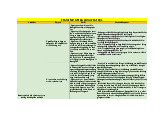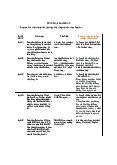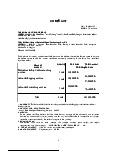


















Preview text:
3
Introduction to Classification: Na¨ıve Bayes and Nearest Neighbour 3.1 What Is Classification?
Classification is a task that occurs very frequently in everyday life. Essentially
it involves dividing up objects so that each is assigned to one of a number
of mutually exhaustive and exclusive categories known as classes. The term
‘mutually exhaustive and exclusive’ simply means that each object must be
assigned to precisely one class, i.e. never to more than one and never to no class at all.
Many practical decision-making tasks can be formulated as classification
problems, i.e. assigning people or objects to one of a number of categories, for example
– customers who are likely to buy or not buy a particular product in a super- market
– people who are at high, medium or low risk of acquiring a certain illness
– student projects worthy of a distinction, merit, pass or fail grade
– objects on a radar display which correspond to vehicles, people, buildings or trees
– people who closely resemble, slightly resemble or do not resemble someone seen committing a crime
© Springer-Verlag London Ltd., part of Springer Nature 2020 21
M. Bramer, Principles of Data Mining, Undergraduate Topics
in Computer Science, DOI 10.1007/978-1-4471-7493-6 3 22 Principles of Data Mining
– houses that are likely to rise in value, fall in value or have an unchanged value in 12 months’ time
– people who are at high, medium or low risk of a car accident in the next 12 months
– people who are likely to vote for each of a number of political parties (or none)
– the likelihood of rain the next day for a weather forecast (very likely, likely, unlikely, very unlikely).
We have already seen an example of a (fictitious) classification task, the
‘degree classification’ example, in the Introduction.
In this chapter we introduce two classification algorithms: one that can be
used when all the attributes are categorical, the other when all the attributes
are continuous. In the following chapters we come on to algorithms for gener-
ating classification trees and rules (also illustrated in the Introduction).
3.2 Na¨ıve Bayes Classifiers
In this section we look at a method of classification that does not use rules,
a decision tree or any other explicit representation of the classifier. Rather, it
uses the branch of Mathematics known as probability theory to find the most
likely of the possible classifications.
The significance of the first word of the title of this section will be explained
later. The second word refers to the Reverend Thomas Bayes (1702–1761), an
English Presbyterian minister and Mathematician whose publications included
“Divine Benevolence, or an Attempt to Prove That the Principal End of the
Divine Providence and Government is the Happiness of His Creatures” as well
as pioneering work on probability. He is credited as the first Mathematician to
use probability in an inductive fashion.
A detailed discussion of probability theory would be substantially outside
the scope of this book. However the mathematical notion of probability corre-
sponds fairly closely to the meaning of the word in everyday life.
The probability of an event, e.g. that the 6.30 p.m. train from London to
your local station arrives on time, is a number from 0 to 1 inclusive, with 0
indicating ‘impossible’ and 1 indicating ‘certain’. A probability of 0.7 implies
that if we conducted a long series of trials, e.g. if we recorded the arrival time
of the 6.30 p.m. train day by day for N days, we would expect the train to be
on time on 0.7 × N days. The longer the series of trials the more reliable this estimate is likely to be.
Introduction to Classification: Na¨ıve Bayes and Nearest Neighbour 23
Usually we are not interested in just one event but in a set of alternative
possible events, which are mutually exclusive and exhaustive, meaning that one
and only one must always occur.
In the train example, we might define four mutually exclusive and exhaus- tive events E1 – train cancelled
E2 – train ten minutes or more late
E3 – train less than ten minutes late E4 – train on time or early.
The probability of an event is usually indicated by a capital letter P , so we might have P (E1) = 0.05 P (E2) = 0.1 P (E3) = 0.15 P (E4) = 0.7
(Read as ‘the probability of event E1 is 0.05’ etc.)
Each of these probabilities is between 0 and 1 inclusive, as it has to be to
qualify as a probability. They also satisfy a second important condition: the
sum of the four probabilities has to be 1, because precisely one of the events
must always occur. In this case
P (E1) + P (E2) + P (E3) + P (E4) = 1
In general, the sum of the probabilities of a set of mutually exclusive and
exhaustive events must always be 1.
Generally we are not in a position to know the true probability of an event
occurring. To do so for the train example we would have to record the train’s
arrival time for all possible days on which it is scheduled to run, then count
the number of times events E1, E2, E3 and E4 occur and divide by the total
number of days, to give the probabilities of the four events. In practice this is
often prohibitively difficult or impossible to do, especially (as in this example)
if the trials may potentially go on forever. Instead we keep records for a sample
of say 100 days, count the number of times E1, E2, E3 and E4 occur, divide
by 100 (the number of days) to give the frequency of the four events and use
these as estimates of the four probabilities.
For the purposes of the classification problems discussed in this book, the
‘events’ are that an instance has a particular classification. Note that classifi-
cations satisfy the ‘mutually exclusive and exhaustive’ requirement.
The outcome of each trial is recorded in one row of a table. Each row must
have one and only one classification. 24 Principles of Data Mining
For classification tasks, the usual terminology is to call a table (dataset)
such as Figure 3.1 a training set. Each row of the training set is called an
instance. An instance comprises the values of a number of attributes and the corresponding classification.
The training set constitutes the results of a sample of trials that we can use
to predict the classification of other (unclassified) instances.
Suppose that our training set consists of 20 instances, each recording the
value of four attributes as well as the classification. We will use classifications:
cancelled, very late, late and on time to correspond to the events E1, E2, E3 and E4 described previously. day season wind rain class weekday spring none none on time weekday winter none slight on time weekday winter none slight on time weekday winter high heavy late saturday summer normal none on time weekday autumn normal none very late holiday summer high slight on time sunday summer normal none on time weekday winter high heavy very late weekday summer none slight on time saturday spring high heavy cancelled weekday summer high slight on time saturday winter normal none late weekday summer high none on time weekday winter normal heavy very late saturday autumn high slight on time weekday autumn none heavy on time holiday spring normal slight on time weekday spring normal none on time weekday spring normal slight on time Figure 3.1 The train Dataset
How should we use probabilities to find the most likely classification for an
unseen instance such as the one below? weekday winter high heavy ????
Introduction to Classification: Na¨ıve Bayes and Nearest Neighbour 25
One straightforward (but flawed) way is just to look at the frequency of
each of the classifications in the training set and choose the most common one.
In this case the most common classification is on time, so we would choose that.
The flaw in this approach is, of course, that all unseen instances will be
classified in the same way, in this case as on time. Such a method of classification
is not necessarily bad: if the probability of on time is 0.7 and we guess that
every unseen instance should be classified as on time, we could expect to be
right about 70% of the time. However, the aim is to make correct predictions
as often as possible, which requires a more sophisticated approach.
The instances in the training set record not only the classification but also
the values of four attributes: day, season, wind and rain. Presumably they are
recorded because we believe that in some way the values of the four attributes
affect the outcome. (This may not necessarily be the case, but for the purpose
of this chapter we will assume it is true.) To make effective use of the additional
information represented by the attribute values we first need to introduce the
notion of conditional probability.
The probability of the train being on time, calculated using the frequency
of on time in the training set divided by the total number of instances is known
as the prior probability. In this case P (class = on time) = 14/20 = 0.7. If we
have no other information this is the best we can do. If we have other (relevant)
information, the position is different.
What is the probability of the train being on time if we know that the
season is winter? We can calculate this as the number of times class = on time
and season = winter (in the same instance), divided by the number of times the
season is winter, which comes to 2/6 = 0.33. This is considerably less than the
prior probability of 0.7 and seems intuitively reasonable. Trains are less likely to be on time in winter.
The probability of an event occurring if we know that an attribute has a
particular value (or that several variables have particular values) is called the
conditional probability of the event occurring and is written as, e.g.
P (class = on time | season = winter).
The vertical bar can be read as ‘given that’, so the whole term can be read
as ‘the probability that the class is on time given that the season is winter’.
P (class = on time | season = winter) is also called a posterior probability.
It is the probability that we can calculate for the classification after we have
obtained the information that the season is winter. By contrast, the prior prob-
ability is that estimated before any other information is available.
To calculate the most likely classification for the ‘unseen’ instance given 26 Principles of Data Mining
previously we could calculate the probability of P (class = on time
| day = weekday and season = winter
and wind = high and rain = heavy)
and do similarly for the other three possible classifications. However there are
only two instances in the training set with that combination of attribute values
and basing any estimates of probability on these is unlikely to be helpful.
To obtain a reliable estimate of the four classifications a more indirect ap-
proach is needed. We could start by using conditional probabilities based on a single attribute. For the train dataset
P (class = on time | rain = heavy) = 1/5 = 0.2
P (class = late | rain = heavy) = 1/5 = 0.2
P (class = very late | rain = heavy) = 2/5 = 0.4
P (class = cancelled | rain = heavy) = 1/5 = 0.2
The third of these has the largest value, so we could conclude that the
most likely classification is very late, a different result from using the prior probability as before.
We could do a similar calculation with attributes day, season and wind.
This might result in other classifications having the largest value. Which is the best one to take?
The Na¨ıve Bayes algorithm gives us a way of combining the prior prob-
ability and conditional probabilities in a single formula, which we can use to
calculate the probability of each of the possible classifications in turn. Having
done this we choose the classification with the largest value.
Incidentally the first word in the rather derogatory sounding name Na¨ıve
Bayes refers to the assumption that the method makes, that the effect of the
value of one attribute on the probability of a given classification is independent
of the values of the other attributes. In practice, that may not be the case.
Despite this theoretical weakness, the Na¨ıve Bayes method often gives good results in practical use.
The method uses conditional probabilities, but the other way round from
before. (This may seem a strange approach but is justified by the method that
follows, which is based on a well-known Mathematical result known as Bayes Rule.)
Instead of (say) the probability that the class is very late given that the
season is winter, P (class = very late | season = winter), we use the conditional
probability that the season is winter given that the class is very late, i.e.
P (season = winter | class = very late). We can calculate this as the number
of times that season = winter and class = very late occur in the same instance,
divided by the number of instances for which the class is very late.
Introduction to Classification: Na¨ıve Bayes and Nearest Neighbour 27
In a similar way we can calculate other conditional probabilities, for example
P (rain = none | class = very late).
For the train data we can tabulate all the conditional and prior probabilities as shown in Figure 3.2. class = on class = late class = very class = can- time late celled day = 9/14 = 0.64 1/2 = 0.5 3/3 = 1 0/1 = 0 weekday day = 2/14 = 0.14 1/2 = 0.5 0/3 = 0 1/1 = 1 saturday day = sunday 1/14 = 0.07 0/2 = 0 0/3 = 0 0/1 = 0 day = holiday 2/14 = 0.14 0/2 = 0 0/3 = 0 0/1 = 0 season = 4/14 = 0.29 0/2 = 0 0/3 = 0 1/1 = 1 spring season = 6/14 = 0.43 0/2 = 0 0/3 = 0 0/1 = 0 summer season = 2/14 = 0.14 0/2 = 0 1/3 = 0.33 0/1 = 0 autumn season = 2/14 = 0.14 2/2 = 1 2/3 = 0.67 0/1 = 0 winter wind = none 5/14 = 0.36 0/2 = 0 0/3 = 0 0/1 = 0 wind = high 4/14 = 0.29 1/2 = 0.5 1/3 = 0.33 1/1 = 1 wind = 5/14 = 0.36 1/2 = 0.5 2/3 = 0.67 0/1 = 0 normal rain = none 5/14 = 0.36 1/2 =0.5 1/3 = 0.33 0/1 = 0 rain = slight 8/14 = 0.57 0/2 = 0 0/3 = 0 0/1 = 0 rain = 1/14 = 0.07 1/2 = 0.5 2/3 = 0.67 1/1 = 1 heavy Prior 14/20 = 2/20 = 3/20 = 1/20 = 0.05 Probability 0.70 0.10 0.15
Figure 3.2 Conditional and Prior Probabilities: train Dataset
For example, the conditional probability P (day = weekday |class = on time)
is the number of instances in the train dataset for which day = weekday and
class = on time, divided by the total number of instances for which class = on
time. These numbers can be counted from Figure 3.1 as 9 and 14, respectively.
So the conditional probability is 9/14 = 0.64.
The prior probability of class = very late is the number of instances in
Figure 3.1 for which class = very late divided by the total number of instances, i.e. 3/20 = 0.15.
We can now use these values to calculate the probabilities of real interest to
us. These are the posterior probabilities of each possible class occurring for a
specified instance, i.e. for known values of all the attributes. We can calculate
these posterior probabilities using the method given in Figure 3.3. 28 Principles of Data Mining Na¨ıve Bayes Classification
Given a set of k mutually exclusive and exhaustive classifications c1, c2, . . . ,
ck, which have prior probabilities P (c1), P (c2), . . . , P (ck), respectively, and
n attributes a1, a2, . . . , an which for a given instance have values v1, v2,
. . . , vn respectively, the posterior probability of class ci occurring for the
specified instance can be shown to be proportional to
P (ci) × P (a1 = v1 and a2 = v2 . . . and an = vn | ci)
Making the assumption that the attributes are independent, the value of
this expression can be calculated using the product
P(ci)×P(a1 = v1 | ci)×P(a2 = v2 | ci)× . . . ×P(an = vn | ci)
We calculate this product for each value of i from 1 to k and choose the
classification that has the largest value.
Figure 3.3 The Na¨ıve Bayes Classification Algorithm
The formula shown in bold in Figure 3.3 combines the prior probability of
ci with the values of the n possible conditional probabilities involving a test
on the value of a single attribute. n
It is often written as P (ci) × P (aj = vj | class = ci). j=1 Note that the Greek letter
(pronounced pi) in the above formula is not
connected with the mathematical constant 3.14159. . . . It indicates the product
obtained by multiplying together the n values P (a1 = v1 | ci), P (a2 = v2 | ci) etc. (
is the capital form of ‘pi’. The lower case form is π. The equivalents in
the Roman alphabet are P and p. P is the first letter of ‘Product’.)
When using the Na¨ıve Bayes method to classify a series of unseen instances
the most efficient way to start is by calculating all the prior probabilities and
also all the conditional probabilities involving one attribute, though not all of
them may be required for classifying any particular instance.
Using the values in each of the columns of Figure 3.2 in turn, we obtain the
following posterior probabilities for each possible classification for the unseen instance: weekday winter high heavy ???? class = on time
0.70 × 0.64 × 0.14 × 0.29 × 0.07 = 0.0013
Introduction to Classification: Na¨ıve Bayes and Nearest Neighbour 29 class = late
0.10 × 0.50 × 1.00 × 0.50 × 0.50 = 0.0125 class = very late
0.15 × 1.00 × 0.67 × 0.33 × 0.67 = 0.0222 class = cancelled
0.05 × 0.00 × 0.00 × 1.00 × 1.00 = 0.0000
The largest value is for class = very late.
Note that the four values calculated are not themselves probabilities, as
they do not sum to 1. This is the significance of the phrasing ‘the posterior
probability . . . can be shown to be proportional to’ in Figure 3.3. Each value
can be ‘normalised’ to a valid posterior probability simply by dividing it by the
sum of all four values. In practice, we are interested only in finding the largest
value so the normalisation step is not necessary.
The Na¨ıve Bayes approach is a very popular one, which often works well.
However it has a number of potential problems, the most obvious one being that
it relies on all attributes being categorical. In practice, many datasets have a
combination of categorical and continuous attributes, or even only continuous
attributes. This problem can be overcome by converting the continuous at-
tributes to categorical ones, using a method such as those described in Chapter 8 or otherwise.
A second problem is that estimating probabilities by relative frequencies can
give a poor estimate if the number of instances with a given attribute/value
combination is small. In the extreme case where it is zero, the posterior proba-
bility will inevitably be calculated as zero. This happened for class = cancelled
in the above example. This problem can be overcome by using a more compli-
cated formula for estimating probabilities, but this will not be discussed further here.
3.3 Nearest Neighbour Classification
Nearest Neighbour classification is mainly used when all attribute values are
continuous, although it can be modified to deal with categorical attributes.
The idea is to estimate the classification of an unseen instance using the
classification of the instance or instances that are closest to it, in some sense that we need to define. 30 Principles of Data Mining
Supposing we have a training set with just two instances such as the fol- lowing a b c d e f Class yes no no 6.4 8.3 low negative yes yes yes 18.2 4.7 high positive
There are six attribute values, followed by a classification (positive or neg- ative).
We are then given a third instance yes no no 6.6 8.0 low ????
What should its classification be?
Even without knowing what the six attributes represent, it seems intuitively
obvious that the unseen instance is nearer to the first instance than to the
second. In the absence of any other information, we could reasonably predict
its classification using that of the first instance, i.e. as ‘negative’.
In practice there are likely to be many more instances in the training set
but the same principle applies. It is usual to base the classification on those of
the k nearest neighbours (where k is a small integer such as 3 or 5), not just the
nearest one. The method is then known as k-Nearest Neighbour or just k-NN classification (Figure 3.4).
Basic k-Nearest Neighbour Classification Algorithm
– Find the k training instances that are closest to the unseen instance.
– Take the most commonly occurring classification for these k instances.
Figure 3.4 The Basic k-Nearest Neighbour Classification Algorithm
We can illustrate k-NN classification diagrammatically when the dimension
(i.e. the number of attributes) is small. The following example illustrates the
case where the dimension is just 2. In real-world data mining applications it
can of course be considerably larger.
Figure 3.5 shows a training set with 20 instances, each giving the values of
two attributes and an associated classification.
How can we estimate the classification for an ‘unseen’ instance where the
first and second attributes are 9.1 and 11.0, respectively?
For this small number of attributes we can represent the training set as 20
points on a two-dimensional graph with values of the first and second attributes
measured along the horizontal and vertical axes, respectively. Each point is
labelled with a + or − symbol to indicate that the classification is positive or
negative, respectively. The result is shown in Figure 3.6.
Introduction to Classification: Na¨ıve Bayes and Nearest Neighbour 31 Attribute 1 Attribute 2 Class 0.8 6.3 − 1.4 8.1 − 2.1 7.4 − 2.6 14.3 + 6.8 12.6 − 8.8 9.8 + 9.2 11.6 − 10.8 9.6 + 11.8 9.9 + 12.4 6.5 + 12.8 1.1 − 14.0 19.9 − 14.2 18.5 − 15.6 17.4 − 15.8 12.2 − 16.6 6.7 + 17.4 4.5 + 18.2 6.9 + 19.0 3.4 − 19.6 11.1 +
Figure 3.5 Training Set for k-Nearest Neighbour Example
A circle has been added to enclose the five nearest neighbours of the unseen
instance, which is shown as a small circle close to the centre of the larger one.
The five nearest neighbours are labelled with three + signs and two − signs,
so a basic 5-NN classifier would classify the unseen instance as ‘positive’ by a
form of majority voting. There are other possibilities, for example the ‘votes’
of each of the k nearest neighbours can be weighted, so that the classifications
of closer neighbours are given greater weight than the classifications of more
distant ones. We will not pursue this here.
We can represent two points in two dimensions (‘in two-dimensional space’
is the usual term) as (a1, a2) and (b1, b2) and visualise them as points in a plane.
When there are three attributes we can represent the points by (a1, a2, a3)
and (b1, b2, b3) and think of them as points in a room with three axes at right
angles. As the number of dimensions (attributes) increases it rapidly becomes
impossible to visualise them, at least for anyone who is not a physicist (and most of those who are).




